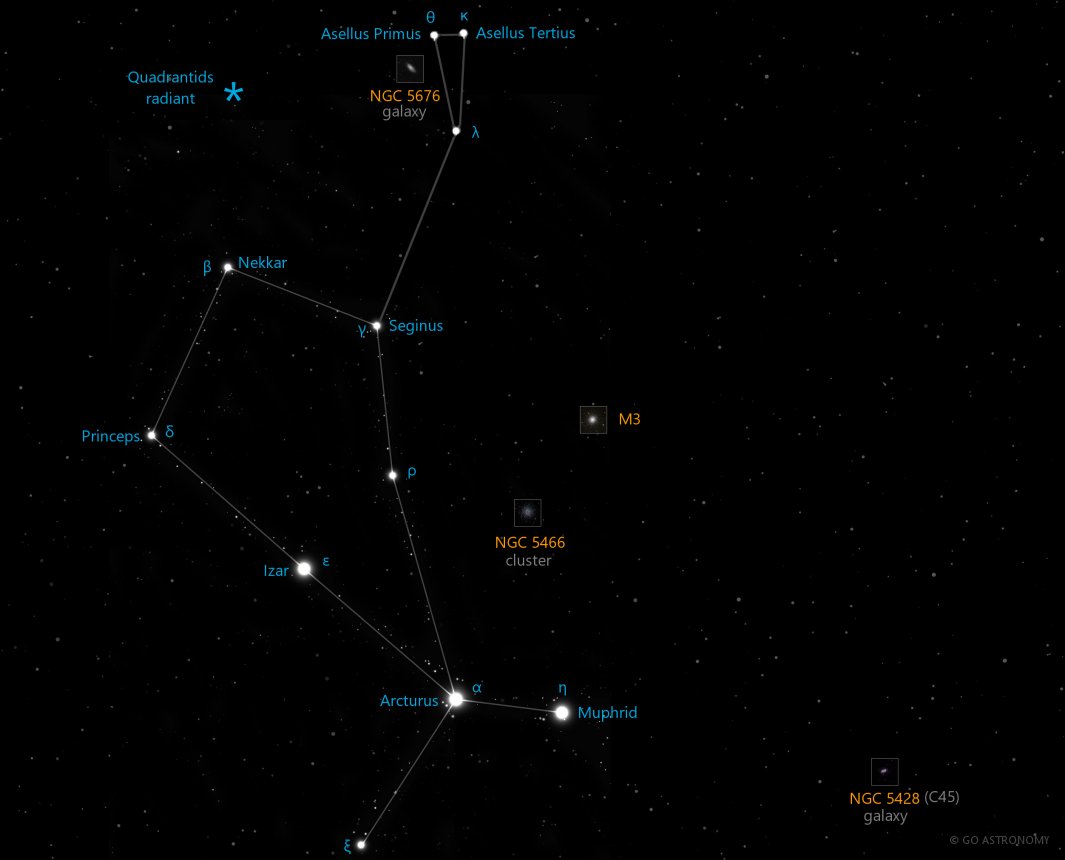Bootes, the Herdsman (Boo)
(boo-OH-teez)
The Northern constellation of Bootes, the Herdsman, is best viewed in Summer during the month of June.
Bootes is the 13th largest constellation. It's brightest star is Arcturus at magnitude -0.04. The boundary of the Bootes constellation contains 14 stars that host known exoplanets.
- Pronunciation:
- boo-OH-teez
- Meaning:
- Herdsman
- Genitive:
- Bootis
- Abbreviation:
- Boo
- Asterism:
- Kite
- Constellation Family:
- Ursa Major
- Hemisphere:
- Northern
- Quadrant:
- NQ3
- Visibility:
- 90° N - 50° S
- Best viewing month*:
- June
- Area:
- 907 sq. degrees
- Size:
- 13th largest
- Right Ascension (avg):
- 14h 41m
- Declination (avg):
- 30°
- Meteor showers:
- Quadrantids
- Brightest star:
- Arcturus (-0.04)
- Stars with planets:
- 14
- Messier objects:
- |
Brightest Stars in Bootes
The 10 brightest stars in the constellation Bootes by magnitude.
- Star
- Magnitude
- Spectral class
- Alpha Bootis (α Boo)
- -0.05
- K2IIIp
- Epsilon Bootis (ε Boo)
- 2.35
- A0
- Eta Bootis (η Boo)
- 2.68
- G0IV
- Epsilon Bootis (ε Boo)
- 2.7
- Gamma Bootis (γ Boo)
- 3.04
- A7IIIvar
- Delta Bootis (δ Boo)
- 3.46
- G8III
- Beta Bootis (β Boo)
- 3.49
- G8III
- Rho Bootis (ρ Boo)
- 3.57
- K3III
- Zeta Bootis (ζ Boo)
- 3.78
- A3IVn
- Theta Bootis (θ Boo)
- 4.04
- F7V
- Mu Bootis (Mu Boo)
- 4.31
- F0 V
Double Stars in Bootes
These are the brightest and easiest-to-find double, triple, and quadruple star systems in the constellation Bootes. Also see all star clusters.
- Star system
- Magnitudes
- Type
- Kappa Bootis
- 4.5, 6.6
- double
- Iota Bootis
- 4.8, 7.4
- double
- Pi Bootis
- 4.9, 5.8
- double
- Epsilon Bootis
- 2.6, 4.8
- double
- Xi Bootis
- 4.8, 7.0
- double
- Delta Bootis
- 3.6, 7.9
- double
- Mu Bootis
- 4.3, 7.1
- double
Star Clusters in Bootes
The most notable and easy-to-find star clusters in the constellation Bootes . Also see all star clusters.
Galaxies in Bootes
The most notable galaxies in the constellation Bootes. Also see all galaxies.
- Name
- Alt name
- Type
- Arp 302
- galaxy pair
- Caldwell 45
- C45
- spiral
- NGC 5544/5545
- galaxy pair
- NGC 5929/5930
- galaxy pair
- NGC5829/IC4526
- galaxy pair
- SDSSCGB 10189
- galaxy group
- Teacup Galaxy
- quasar
Milky Way Satellites in Bootes
Dwarf satellite galaxies that orbit the Milky Way Galaxy located in the constellation Bootes. Also see all Milky Way satellite galaxies.
- Galaxy name
- Alt name
- Magnitude
- Bootes I
- 13.1
- Bootes II
- Bootes III
- Bootes IV
The Herdsman of the Stars
Bootes, the Herdsman, is a prominent constellation of the northern celestial hemisphere, renowned for its historical significance, intriguing mythology, and captivating astronomical features. With bright stars and notable deep-sky objects, Bootes presents an enticing realm for both novice stargazers and seasoned astronomers alike.
Historical and Mythological Overview
Bootes is one of the 48 constellations listed by the 2nd-century Greco-Roman astronomer Claudius Ptolemy, and it remains one of the 88 modern constellations officially recognized by the International Astronomical Union. Its representation as a herdsman or plowman has roots in ancient Greek astronomy, although various cultures have bestowed their own interpretations upon this celestial figure. In Greek mythology, Bootes is often associated with Arcas, the son of Zeus and Callisto, who was placed in the sky by Zeus.
Location and Key Features
Bootes covers 907 square degrees, making it the 13th largest constellation in the night sky. It's situated in the third quadrant of the Northern hemisphere (NQ3) and can be seen at latitudes between +90? and -50?. The constellation is bordered by constellations such as Canes Venatici, Coma Berenices, Corona Borealis, Draco, Hercules, Serpens Caput, Ursa Major, and Virgo.
The brightest star of Bootes, Arcturus (Alpha Bootis), is the fourth-brightest star in the night sky and the brightest in the Northern Hemisphere. This red giant star lies approximately 37 light-years from Earth and has an apparent magnitude of -0.05, making it easily visible even from urban locations. Other significant stars include Izar (Epsilon Bootis), a binary star, and Muphrid (Eta Bootis), a close neighbor to Arcturus.
Deep Sky Objects
Although Bootes is best known for its bright stars, particularly Arcturus, it also houses a number of fascinating deep-sky objects. These include several galaxies such as the Bootes Dwarf Galaxy, a satellite of the Milky Way, and the Bootes void, a vast, nearly empty region of space. NGC 5466, a globular cluster, is also part of Bootes and is especially notable as the source of a star stream that wraps around our galaxy.
Observing Bootes
Bootes' location and distinct kite shape make it fairly easy to find in the night sky. In the Northern Hemisphere, the constellation is best seen in the evening from spring through summer. By following the curve of the Big Dipper's handle, an arc can be traced to Arcturus, Bootes' brightest star, following the adage "arc to Arcturus".
While Arcturus dominates the constellation, other stars and deep-sky objects in Bootes provide intriguing targets for observation. With a small to mid-sized telescope, observers can catch a glimpse of the binary star Izar, and those with larger telescopes and dark sky conditions may attempt to spot the globular cluster NGC 5466 or galaxies within the constellation's borders.
* Constellation shown for northen hemisphere skies. For the southern hemisphere, constellations appear rotated 180 degrees (upside-down and left-right reversed) from what is shown. Remember that seasons are reversed too - summer in northern latitudes is winter in southern latitudes.
** Circumpolar constellations are visible year-round in the hemisphere listed (and not at all in the opposite hemisphere).





